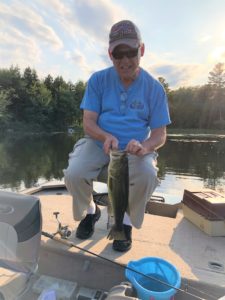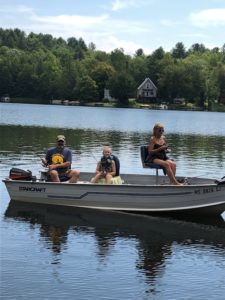With the hot weather that we have had recently, our local rivers have basically shut down with regards to trout fishing. They require colder waters, preferably under 70 degrees Fahrenheit. There is still good trout fishing in some of our deeper local lakes.
But for some anglers, they have put down the trout fly rod or spinning outfits, picked up their bass fishing gear and headed for the lakes, preferably those with some lily pads. If you have had a chance to look out onto a lake in the early mornings or early evenings at this time of the year, chances are good that you will see anglers in boats quietly bass fishing.
Anglers can bass fish year-round now in MA, but it wasn’t always that way. Back when fishing seasons didn’t open until mid-April, anglers could not catch and keep bass before June 15. The reason was that the bass were on their spawning beds until then and it was felt that they shouldn’t be pulled off of those beds leaving their eggs and/or small fry exposed to predators such as sun fish and perch. Some states like nearby New York still don’t allow bass fishing until that date.
Some of us are from the old school and still don’t fish for them until after June 15, and then we fish for them all summer long.
There are different methods of bass fishing- from using live bait with bobbers, to spoons and spinners, to rubber imitations of worms, crayfish and other critters. They all work well.
My preference for catching bass is the old fashioned topwater bass plug. To me there is nothing more exciting than the heart-stopping thrill of a bass coming to the surface and slamming that plug, followed by splashing, jumping, deep diving, etc. And if I am using a 50 or 60 year-old plug such as a Heddon River Runt or Baby Zara, a Fred Arbogast Crazy Crawler or Jitterbug, a Rapala bait fish imitation or a Helin’s Flatfish, all the better. I’ll bet some of you “more experienced” anglers are still using the old red and white Bass-O-Reno plug. They may be old with dings and teeth marks, but they still work.
There are a lot of bass out there in our lakes these days, partly because we have some nice, healthy waters and partly because more anglers now are practicing “catch and release”, resulting on more larger fish swimming around. That’s not to say that one should feel guilty when taking a bass home to eat now and then, but the catch and release concept has really taken hold these days in bass and trout fishing.
I like to link up with my nephews Joe and Jim Chague, buddy Doug Yates and others and go bass fishing on Friday nights. It’s a nice way to end the work week (even though I am long retired). Pictured here is a nice bass caught recently by Doug on a Heddon “Zara Puppy” bass plug, using the “Walking the dog” fishing method. Manipulated in a certain way, the plug looks like a small fish jumping out of the water chasing an insect. The big bully bass can’t stand that and pounce onto the imitation.
Manipulated in a certain way, the plug looks like a small fish jumping out of the water chasing an insect. The big bully bass can’t stand that and pounce onto the imitation.
Its always nice to see families out fishing, such as the one shown in another attached picture. Grandparents Sue Joyner of Hinsdale and Gary Ouimet of Dalton took young Aralyn fishing last weekend. They had a nice day with Sue catching 4, Gary catching 3 and Aralyn catching 2 bass. All of them were released. Aah, it doesn’t get any better!
Aralyn is no novice when it comes to fishing. Two years ago, she won a “Lunker Derby” by catching a 4 ½ lbs. fish and taking home the $60 first prize money.
More on MassWildlife Habitat Programs
Readers may recall that last week this column dealt with MassWildlife’s Habitat Programs. Mass Fisheries & Wildlife Board Vice Chairman Mike Roche recently wrote an excellent piece about the same topic coming at it from a different angle, that being carbon storage and release. Here are some excerpts of what he wrote:
“MassWildlife has, for many years, planned the forest management on MassWildlife Wildlife Management Areas (WMA) for a number of purposes. The stewardship of the wildlife, plants and insects is always part of the equation but so are the important issues of carbon storage and release as they relate to Climate Change. A very detailed and informative presentation was given to the Fisheries and Wildlife Board at a recent meeting by Brian Hawthorne, Habitat Planning Coordinator, that included data analysis of the work done on MassWildlife lands and the impact, now and going forward.
As part of ongoing efforts to support Governor Baker’s Executive Order on Climate Change, and to implement the Global Warming Solutions Act, MassWildlife recently completed a detailed accounting of carbon storage and carbon release on state Wildlife Management Areas. The results from this carbon budget analysis showed that the amount of carbon released during selective tree clearing carried out during habitat management projects is a tiny fraction of carbon storage gained by tree and plant growth on the agency’s 170,000 acres of forested WMAs. Conducting habitat management provides a vital boost to rare and dwindling animals and plants that rely on open habitats and allows MassWildlife to fulfill its mission. “The Division of Fisheries and Wildlife is proud to incorporate climate change adaptation and mitigation principles into its mission to conserve biological diversity in Massachusetts,” says John Scanlon, MassWildlife’s Habitat Program Leader. “We are able to manage habitat for all kinds of wildlife while substantially contributing to carbon sequestration in Massachusetts.”
MassWildlife protects and manages over 220,000 acres of wildlife lands across the state, including WMA’s and Wildlife Conservation Easements, for wildlife to thrive and for people to enjoy. The agency is recognized as a national leader in incorporating climate change adaptation and mitigation principles into its statewide wildlife conservation mission. Climate change is driven by increased concentrations of greenhouse gases, mainly carbon dioxide, in the atmosphere. As they grow, trees and other forest plants help reduce greenhouse gases by storing large amounts of carbon in wood, root systems, and soils. MassWildlife is committed to managing the vast majority of its land as forest and recognizes that every acre the agency and its conservation partners permanently protect from development contributes to climate change mitigation efforts.
In 2006, MassWildlife habitat biologists conducted a comprehensive inventory of forests on WMAs and found that its wooded lands stored 10.3 million tons of carbon. Between 2007 and 2018, MassWildlife acquired additional lands which contributed to another 2.6 million tons of carbon storage. In addition, between 2007 and 2018, forest growth across all MassWildlife lands sequestered an additional 1.2 million tons of carbon. MassWildlife lands currently store a grand total of just over 14 million tons of carbon.
On the other side of the equation, MassWildlife staff calculated carbon release tonnage from habitat management activities. MassWildlife regularly performs habitat management on WMAs including tree clearing. These actions restore and maintain open habitat types that are crucial to the conservation of many kinds of uncommon or rare animals and plants. These habitat management practices release carbon, but how much? The results from the carbon budget analysis showed that since 2006, MassWildlife’s habitat management activities have released only about 20,000 tons of carbon. This is just 1.7% of the 1.2 million tons of new carbon storage gained on WMAs from forest growth since 2006.
Scanlon says that the agency’s habitat management activities are critical for rare and declining wildlife like whip-poor-will, New England cottontail, and a variety of butterflies and moths. “Forest cutting also directly benefits game species such as ruffed grouse and American woodcock. At the same time, we are doing our part in storing carbon.” Scanlon notes that MassWildlife is currently working to calculate carbon storage and release measurements on its Wildlife Conservation Easement lands.
Sportsmen have long recognized the wildlife value of forest cutting and it is easy to observe the changes in the following years after the work is done. Both game species and non-game species tend to become more abundant and that is not lost on hunters and birdwatchers”.
Berkshire Outdoorsman
Hunting and fishing in the Berkshires, MA
